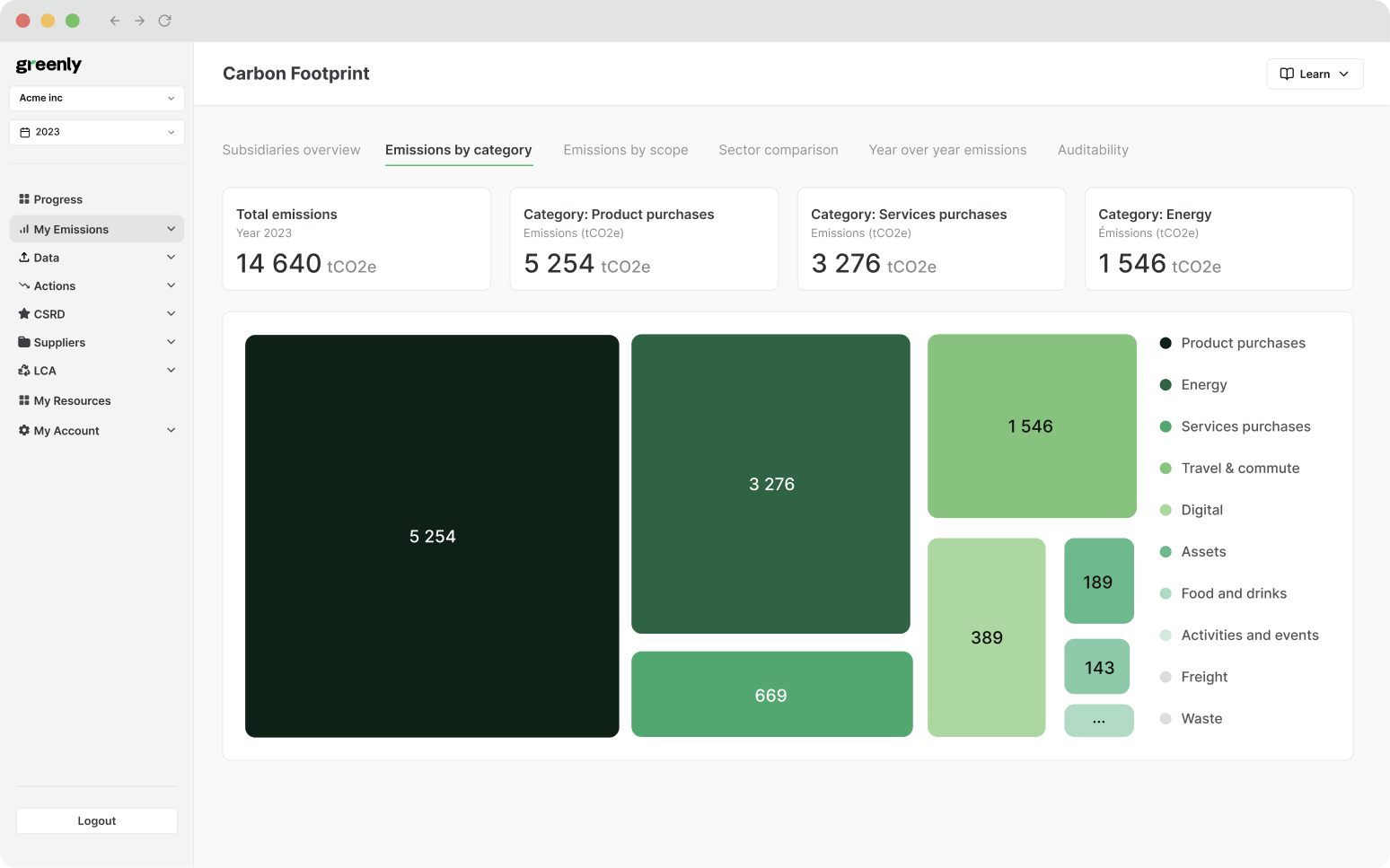ESG / CSR
Industries
5 Things to Know About Bioplastic



As the globe continues working towards greater sustainability, individuals and companies around the world are becoming increasingly cognizant of the effects of plastic – but what about bioplastic?
Bioplastic refers to plastics that are made with biodegradable properties in hopes of helping to reduce the current environmental impact of traditional plastic.
This is increasingly important as the world grows concerned with the current effects of single use plastic, seeing as we produce 400 million tons of plastic waste each year.
In this article, we’ll explain what bioplastic is, its main goal, and five things to know about bioplastic.
What is bioplastic?
Bioplastic is a type of plastic made from various biological materials, such as corn starch, sugarcane, potato starch, or algae.
As a result, bioplastics were designed as an attempt to be more eco-friendly – with some bioplastics even being biodegradable or compostable.
What are the different types of bioplastic?
In general, there are three different types of bioplastics:
- Biodegradable Plastic – This type of bioplastic is made when micro-organisms work to convert materials into natural substances – like biomass, water, or carbon dioxide. This type of bioplastic is especially useful for shopping bags, wrapping, and agricultural films – as these are the types of plastics that are often discarded improperly and can take ages to decompose if manufactured with traditional plastic. An example of this kind of bioplastic is Bio-PE (Bio-based polyethylene), which is made with sugarcane.
- Biobased Plastic – This type of bioplastic refers to material that has been made either partially or entirely from biomass – such as from corn, sugarcane, or cellulose. An example of this type of bioplastic includes PLA (Polylactic Acid – which is most often used for disposable cutlery.
- Compostable Plastic – This is a type of biodegradable plastic which can decompose into natural elements if it is composted under industrial conditions, such as with PHA (Polyhydroxyalkanoates), used for medical applications and food packaging.
What makes bioplastic different from traditional plastic?
Bioplastic is different from conventional plastic seeing as bioplastic is biodegradable, and traditional plastic is not – as it can take hundreds of years to decompose in our landfills and contribute to excess GHG emissions.
Overall, bioplastic serves as a way for us to continue utilizing the flexible properties of plastic without further harming the environment – as biodegradable and compostable plastic can help to lessen the amount of GHG emissions created on behalf of traditional plastic.

What is the purpose of bioplastic?
The main goal of using bioplastic is to mitigate the current negative effects that plastic waste is creating on the environment.
Over 20 million tons of plastic waste end up in our environment every year, whether that be in the ocean with microplastics or by contributing to plastic pollution on land – and this number is only expected to rise by 2040.
Here are some reasons why bioplastic serves a purpose in our modern society:
- Decrease Dependence on Fossil Fuels – Traditional plastic requires the use of finite resources to be produced, such as petroleum – where as bioplastic makes use of renewable resources like plants. Ultimately, this can help us to reduce our current dependency on fossil fuels and other sparse resources.
- Encourage the Importance of Composting – Some bioplastic such as compostable plastics will allow food waste to benefit the surrounding soil and ecosystem without rotting in landfills, which in turn – can help to promote the importance of composting as a whole.
- Help Decarbonize Business Operations – Businesses looking to reduce their own environmental impact may benefit from the use of bioplastic, as its a more sustainable material that can help to boost additional recycling, composting, and eco-friendly policies within the organization.
- Highlight the Existence of Alternative Disposal Options – When it comes to plastic, we’re hardwired to believe that recycling is the only way to ensure plastic doesn’t contribute to additional waste – but bioplastic helps to illustrate the alternative methods to ensure plastic doesn’t further harm the environment.
Why is the push for bioplastic important?
As we continue to tread towards reaching peak oil, our depleting reserves of fossil fuels will make it challenging for the plastic industry to continue as it is – making it all the more imperative for bioplastics to step into the spotlight.
Bioplastic, while not a perfect solution, can still offer a way to manage plastic waste more effectively as opposed to recycling and tossing traditional plastic in the landfill. This is because bioplastic can often be turned into harmless byproducts within six months, making its long-term impact far less detrimental in comparison to traditional plastic.
Ultimately, bioplastics are valuable in our modern world as they offer a sustainable alternative to traditional plastic and can help to mitigate the current negative effects of plastic pollution.
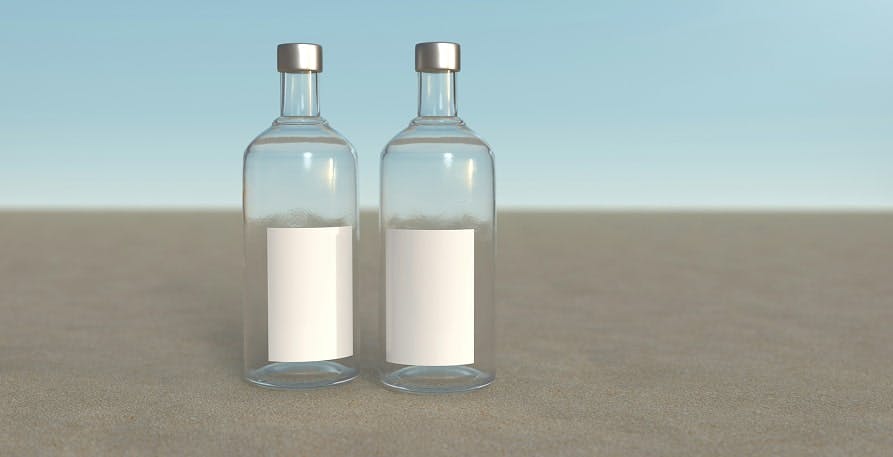
What are 5 things to know about bioplastic?
There are numerous benefits and drawbacks to the use of bioplastic, such as how it can help us to lower our carbon footprint and reduce our dependence on fossil fuels – but on the flip side, bioplastic can be challenging to decompose and also require higher initial production costs, making it less accessible for all businesses.
Bioplastic isn’t a perfect solution, meaning that it is important for individuals and businesses alike to understand the unique pros and cons associated with bioplastic before engaging in their use.
Here are five things you should know about bioplastics before using them:
1. Bioplastics take time to decompose
On the surface, it may seem to many as though bioplastic is magical “one-size-fits-all” solution for traditional plastic – but what many people don’t understand is that bioplastic doesn’t decompose instantaneously and takes some time.
On average, bioplastic still takes anywhere from weeks to months to completely decompose – meaning that the impact it creates during the in-between is something to keep in mind.
For example, while bioplastic can help to reduce the amount of greenhouse gas emissions associated with the production of traditional plastic (such as by reducing U.S. greenhouse gas emissions by 25% – bioplastic would need to be produced with renewable energy resources to ensure it doesn’t pollute to the same extent as traditional plastic.
2. Bioplastic may not be compostable without industrial assistance
In addition to the fact that bioplastic isn’t as easily biodegradable as it may seem, businesses should remain aware that some bioplastic will require industrial processes to fully decompose back into the Earth.
This is important to consider, as it may mean that switching to the use of bioplastic may be futile if your company doesn’t have the full amount of time or resources to fully ensure that the bioplastic of your choice will fully degrade back into the environment.
Bioplastics that may not fully decompose without industrial processes include:
- PLA (Polylactic Acid) as it requires high heat and moisture from industrial composting
- PHA (Polyhydroxyalkanoates) as it may demand industrial composting to fully break down
- PBS (Polybutylene Succinate) as it relies on industrial composting to be completely broken down
- Starch-Based Bioplastics as specific bipastic blends may not be able to fully decompose in nature on their own
3. Bioplastic is safer for human health
Although bioplastic can prove challenging to fully decompose back into the environment, there are still valuable upsides worth noting – such as how bioplastic is often free from harmful chemicals like BPA.
BPA, or Bisphenol A, is a chemical compound which is mainly used when manufacturing plastic – and can impact human health by contributing to increased blood pressure, type 2 diabetes and cardiovascular disease.
Overall, bioplastic avoids the use of BPA – making it a healthier and safer alternative to traditional plastic.
4. Bioplastic can be more expensive
Although bioplastic can be better for our bodies, it can also prove more expensive than conventional plastics – meaning that it may not be an accessible, eco-friendly alternative for all individuals and businesses.
Since bioplastic is made from more naturally derived materials, it can cost anywhere from 20 to 30% more than conventional plastic.
5. Bioplastic is resource intensive
It’s true that bioplastic is made from more natural elements as opposed to traditional plastic, but this also means that bioplastic is more resource intensive than conventional plastic.
This is because bioplastic requires crops to grow to harvest all the necessary materials needed to manufacture bioplastic, which can lead to land-use conflicts with food production.
The table below will list additional facts about bioplastic:
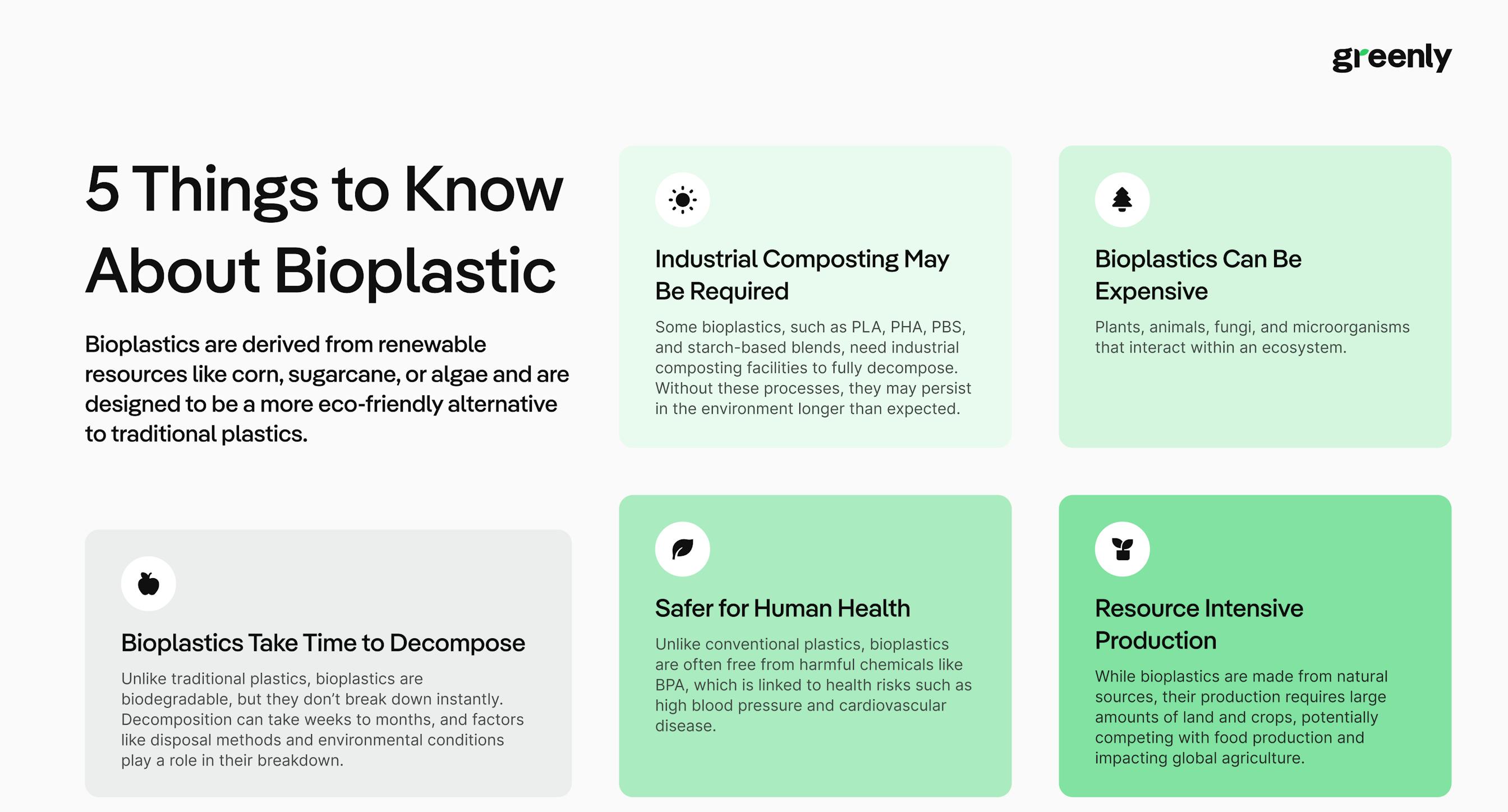

| Fact | Explanation |
|---|---|
| Reduces Carbon Footprint | Bioplastics, especially those derived from renewable sources, absorb CO₂ during plant growth, helping lower overall emissions. |
| Not All Bioplastics Are Biodegradable | Some bioplastics, like Bio-PET, behave like traditional plastics and do not break down naturally. |
| May Contaminate Recycling Streams | Bioplastics mixed with conventional plastics can disrupt recycling processes if not properly sorted. |
| Requires Specific Disposal Methods | Compostable bioplastics need industrial composting facilities to break down efficiently. |
| Potential for Agricultural Land Use Competition | Growing crops for bioplastic production may compete with food agriculture, leading to land use concerns. |
| Can Be Made from Food Waste | Some bioplastics, like PHA, can be produced from food waste and organic byproducts, reducing overall waste. |
| UV and Heat Sensitivity | Certain bioplastics degrade faster when exposed to sunlight and high temperatures, limiting their applications. |
| Ongoing Research & Development | Scientists are working on improving bioplastics to make them more durable, cost-effective, and widely biodegradable. |
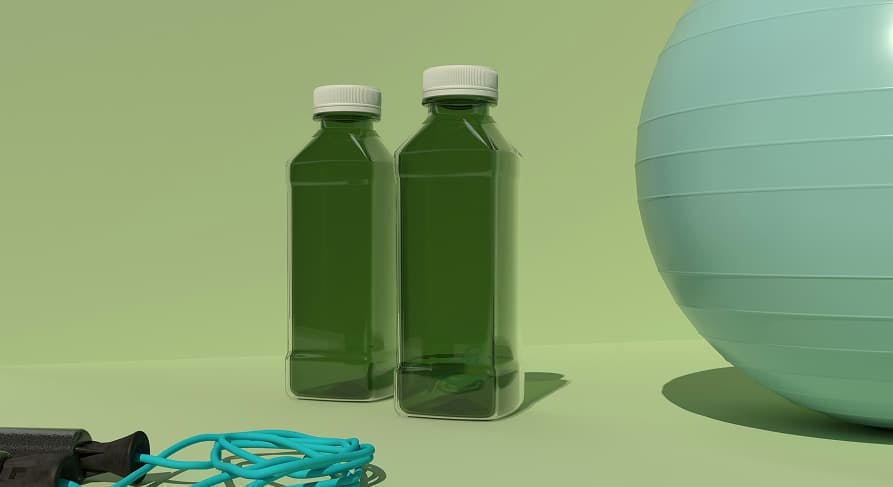
Should your company switch to the use of bioplastic?
Your company should make an effort to switch to the use of bioplastic, but only if you can afford the additional costs and resources required to ensure that they fully degrade into the environment.
If you do decide to switch to the use of bioplastic, it’s worth conducting research on the different types of bioplastic and which may be most suitable for your company.
Here are a few examples to look into when it comes to bioplastic:
- Polylactic Acid (PLA) which is best for textile, packaging, and food services
Polyhydroxyalkanoates (PHA) which is best for medical and agricultural purposes - Starch-Based Bioplastics which is best for shopping bags and plant pots
- Cellulose-Based Bioplastics which is good for clothing fibers and various consumer goods
- Bio-Polyethylene (Bio-PE) which is best for fuel tanks and the automotive industry
- Bio-Polyethylene Terephthalate (Bio-PET) which is suitable for food containers and soft drink bottles
- Polybutylene Succinate (PBS) which is good for mulch films and other agricultural packing purposes
However, in the event that bioplastic is not an attainable resource for your company – here are some viable alternatives to avoid the use and impact of traditional plastic:
- Sustainable Packaging – Opt for other sustainable packaging materials like bamboo, straw, hemp, mushroom film, compostable paper-based packaging, and more to use when wrapping your products. This can help to avoid the use of single-use plastic without committing to the price tag of bioplastic.
- Set-Up Recycling & Compost Bins in the Office – While recycling management is an issue of itself, setting up a recycling and even composting bin in the office can help to motivate your employees to further educate themselves and participate in sustainable initiatives.
- Upcycling – Although upcycling more often refers to people repurposing old materials in their own homes, such as turning an old space jar into a pencil container, upcycling can also come in handy for businesses – as it allows your employees to get creative and discover new ways to make use of old scrap materials.
Overall, bioplastic can help us to mitigate the detrimental effects of traditional plastic – but it is also important to consider its downside before utilizing it, and to remain aware of the other ways your business can go green.
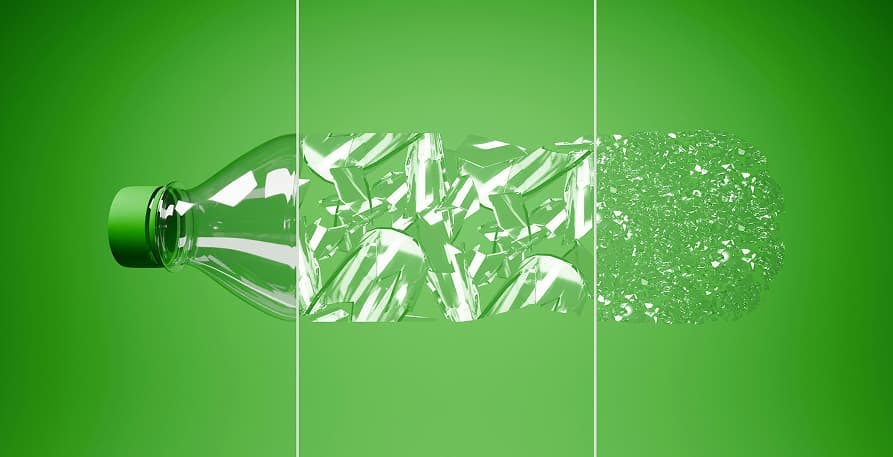
What about Greenly?
If reading this article about bioplastic has inspired you to consider your company’s own carbon footprint, Greenly can help.
At Greenly we can help you to assess your company’s carbon footprint, and then give you the tools you need to cut down on emissions. We offer a free demo for you to better understand our platform and all that it has to offer – including assistance on how to reduce emissions, optimize energy efficiency, and more to help you get started on your climate journey.
Learn more about Greenly’s carbon management platform here.
